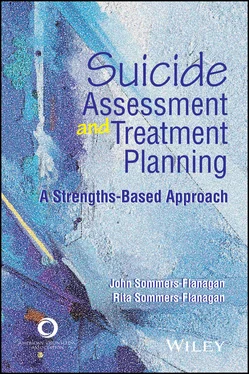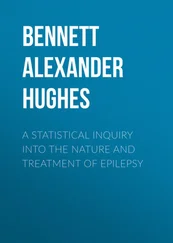John Sommers-Flanagan - Suicide Assessment and Treatment Planning
Здесь есть возможность читать онлайн «John Sommers-Flanagan - Suicide Assessment and Treatment Planning» — ознакомительный отрывок электронной книги совершенно бесплатно, а после прочтения отрывка купить полную версию. В некоторых случаях можно слушать аудио, скачать через торрент в формате fb2 и присутствует краткое содержание. Жанр: unrecognised, на английском языке. Описание произведения, (предисловие) а так же отзывы посетителей доступны на портале библиотеки ЛибКат.
- Название:Suicide Assessment and Treatment Planning
- Автор:
- Жанр:
- Год:неизвестен
- ISBN:нет данных
- Рейтинг книги:4 / 5. Голосов: 1
-
Избранное:Добавить в избранное
- Отзывы:
-
Ваша оценка:
- 80
- 1
- 2
- 3
- 4
- 5
Suicide Assessment and Treatment Planning: краткое содержание, описание и аннотация
Предлагаем к чтению аннотацию, описание, краткое содержание или предисловие (зависит от того, что написал сам автор книги «Suicide Assessment and Treatment Planning»). Если вы не нашли необходимую информацию о книге — напишите в комментариях, мы постараемся отыскать её.
Suicide Assessment and Treatment Planning — читать онлайн ознакомительный отрывок
Ниже представлен текст книги, разбитый по страницам. Система сохранения места последней прочитанной страницы, позволяет с удобством читать онлайн бесплатно книгу «Suicide Assessment and Treatment Planning», без необходимости каждый раз заново искать на чём Вы остановились. Поставьте закладку, и сможете в любой момент перейти на страницу, на которой закончили чтение.
Интервал:
Закладка:
Although we have only minimal information about Alina in the opening case presentation, the seven-dimension model can contribute to a holistic understanding of her and her situation. We offer a brief description of how you might use the dimensional model to guide further assessment and treatment planning.
Emotional Dimension
Alina’s previous attempt, her cutting behaviors, and her presenting affect speak to her intense distress. At a minimum, initial work with her could focus on strategies for emotional regulation and practical methods for distress tolerance.
Cognitive Dimension
Alina’s statement about not being sure that anything will ever help her feel better is an indication of hopelessness. Much more assessment is needed, but beginning with questions about what gives her hope and what diminishes her hope is a reasonable place to start.
Interpersonal Dimension
Alina is isolated and lonely. Not only does she long for a romantic relationship, but she also feels estranged from her family. Gathering more information about her relationship history, patterns, hopes, and skills is essential to building a comprehensive treatment plan.
Physical Dimension
Alina is opposed to antidepressant medications. To provide a complete treatment plan, it is important to gather more information about her medical history and her exercise, sleep, and nutritional habits.
Cultural-Spiritual Dimension
Alina’s sexual identity may have made her a target for micro- or macroaggressions as well as cultural oppression. In addition, it would be helpful to know more about Alina’s Croatian culture and whether components of that culture contribute to her wellness or suicidality. More assessment information is needed about the role of spirituality or religion in her life.
Behavioral Dimension
Although Alina denies suicidal intent, she may be engaging in behaviors that increase her vulnerability to suicide. Within the behavioral dimension, assessing Alina’s substance use and previous overdose is essential. In addition, making sure Alina does not have easy access to firearms or other lethal means is essential and can be addressed in a collaborative safety plan.
Contextual Dimension
Gathering information about Alina’s living conditions and her unemployment situation is important. Helping Alina identify community supports, identify financial resources, and understand the potential role of discrimination in her life may help decrease distress and provide a sense of direction.
Concluding Comments
We would love to offer a clear and easy formula for preventing all suicides, but we cannot; no one can. Suicide rates are on the rise, and suicide is neither 100% predictable nor 100% preventable. Regardless of these discouraging realities, people struggling with suicidal thoughts and impulses need the best care available. Providing the best care requires professionals who are comfortable and skilled when working with client suicidality.
Facing the daunting professional task of providing suicide assessment and treatment services may leave you feeling overwhelmed. Feeling overwhelmed—including having self-doubt and anxiety—is part of a normal developmental process linked to learning about suicide assessment and treatment. As you progress through these chapters, your knowledge and skills will grow and your feelings of being overwhelmed will shrink.
Practitioner Guidance and Key Points to Remember
Over the course of your professional life, you are likely to have many people who are suicidal on your caseload. As you face the stress that these situations evoke, you will benefit from developing personal and professional self-care strategies. In this chapter, we recommended the following:
Stop reading (take breaks from suicide content as needed).
Recognize the hazards inherent to working with people who are suicidal.
Intentionally focus on positive and rewarding life experiences.
Use a variety of self-care strategies.
Accept your distress and engage in self-soothing behaviors.
In addition to developing self-care strategies, you also need to manage your attitudes toward suicide, including your personal values. Ethical bracketing—or setting aside your personal values to focus on your clients—is one method of preventing your personal values and attitudes from negatively affecting clients. We recommend using Kocet and Herlihy’s (2014) five-step counselor values-based conflict model to facilitate ethical bracketing.
Currently, the functional model for treating suicidality has the strongest evidence base. The functional model is used to identify psychopathological processes that underlie suicidal thoughts and behaviors and target them in treatment. Similar to the functional model, our suicide assessment and treatment model targets suicidal thoughts and behaviors within the context of the individual’s history and present circumstances. However, the model used in this book is a wellness-oriented, strengths-based, and holistic model that views suicidality through the lens of seven dimensions of human functioning:
Emotional
Cognitive
Interpersonal
Physical
Cultural-Spiritual
Behavioral
Contextual
The seven-dimension model is a foundation for focusing on the whole person—including personal strengths—as you develop treatment plans for clients who are suicidal. Counselors and other professionals who are working with clients contemplating suicide are encouraged to gently and collaboratively explore the questions “Where does it hurt?” “How can I be of help?” and “Where are you strong?”
Chapter 2
Competence and Ethics
Imagine you are working with Kevin, a 21-year-old college student. Kevin identifies as a White cisgender heterosexual male. He is mandated to see you for five sessions after receiving a campus citation for using alcohol in his dorm. During your first three sessions, he strikes you as affable, engaging, and relatively well adjusted. He is physically fit, gets good grades, and does not seem depressed. Kevin acknowledges that his father had problems with alcohol; he openly admits to guilt over his own use. During the second session, Kevin expresses an interest in cutting back on drinking, partly because of his father’s problems and partly because his girlfriend thinks he drinks too much. Then, after his third session, out of the blue, you get a call from his girlfriend. She tells you she is breaking up with Kevin, and he is threatening suicide. She says, “Kevin needs to see you right away,” and asks you to call him. Tragically, before you make contact, Kevin places the barrel of a gun in his mouth, pulls the trigger, and dies by suicide.
In the swirling aftermath of Kevin’s suicide, you are emotionally devastated. You keep replaying session vignettes in your mind, wondering, “How could this have happened?” and “What did I miss?” Your confidence is shaken. You are questioning your professional competence.
Understanding Suicide Competence
Suicide competence refers to what clinicians need to know and do to provide professional services to clients at risk for suicide. In a general sense, suicide competencies encompass three parts of a symphony that includes many different notes, movements, and melodies. Like all competency models (Cramer et al., 2013), these three parts include the following:
Self-awareness and attitudes. This includes developing greater awareness of your own attitudes toward suicide and how your attitudes, beliefs, and personal values might play out in specific clinical scenarios. Exploring your attitudes toward suicide helps you cope with personal and emotional reactions while maintaining a therapeutic relationship and implementing state-of-the-art suicide assessment and treatment planning procedures.
Читать дальшеИнтервал:
Закладка:
Похожие книги на «Suicide Assessment and Treatment Planning»
Представляем Вашему вниманию похожие книги на «Suicide Assessment and Treatment Planning» списком для выбора. Мы отобрали схожую по названию и смыслу литературу в надежде предоставить читателям больше вариантов отыскать новые, интересные, ещё непрочитанные произведения.
Обсуждение, отзывы о книге «Suicide Assessment and Treatment Planning» и просто собственные мнения читателей. Оставьте ваши комментарии, напишите, что Вы думаете о произведении, его смысле или главных героях. Укажите что конкретно понравилось, а что нет, и почему Вы так считаете.











